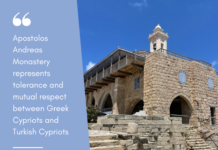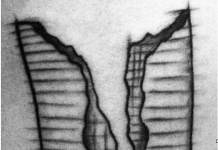The everyday’s life in the neighborhood I’m living in is made up by different forms of experiences involving all five senses. Days and nights are marked by the adhan, the muezzin’s calling for the believers, whose voice reaches both our apartment and the shelter for Unaccompained Minors of “Hope for Children” in which I am serving as a volunteer with my ESC colleagues. Due to the proximity of the buffer zone and the Turkish Republic of Northern Cyprus, vibrations from minarets standing out in the part of the island which declared itself independent in 1974 can be perceived, too. Similarly, it is possible to listen the bells ringing and the echoes of the believers’ voices singing in the very numerous churches hidden in the narrow streets of the historical city center. Walking through these passages on Sunday, to go to the shelter for the morning shift, is quite a spiritual experience. Indeed, one step away from home, the sounds of the Sunday Services radiate from the interior of Trypiotis Church: built in 1695 by Archbishop Germanos and dedicated to the Archangel Michael, it is considered an important architectural example of the Franco – Byzantine Era. The traject towards the shelter is quite solitary, as no one is on the streets but you, until you meet few people standing in front of Ayios Eleftherios Chapelpatron, patron of all slaves, in Onasagorou Street, from where you may hear the worshippers and the minister’s voices and chants. This chapel, built by Archbishop Kyprianos in the 12th century, is a real treasure of the city, as it impresses visitors with its unique architecture.
As a consequence, the daily life of people dwelling the area is cadenced by the Selimiye Mosque in the North and Omeriye Mosque in the South, as well as by the sounds coming from the numerous churches. The majority religion in Cyprus, in fact, is that of Greek Orthodox: it is esteemed that around 72% of people in the island consider themselves to be Christian. Actually, the Church of Cyprus is one of the oldest independent churches in the world, being founded by Paul the Apostle in 45 CE. Despite the fact that new generations have a weaker bond with religiosity, the Ortodox Church continues to be influential in the cultural, social and in the daily life of Cypriots. But Christianism in the island is much multifaceted. In fact, even if the overall picture of Cyprus is usually shaped by the so-called bi-communalism, focusing on the two main ethnic and religious groups that are Islam and the Greek Orthodox Church, the 1960 Constitution also explicitly mentions the Armenians, Maronites and Latins. There is no doubt that the history of Cyprus and its cities reflect the history of the relationships between Islam, introduced in the 16th century after the island became part of the Ottoman Empire, and Christianity. This relationship can also be materially represented by the Omeriye Mosque, originally a church of the Order of the Augustinians dedicated to St. Mary. Nevertheless, on the one hand, as already mentioned, Christianism includes a big array of Churches, along with the Orthodox. On the other hand,
“While the general understanding of ‘bi-communalism’ reflects historic and contemporary realities, there is more religious diversity on the island than this concept suggests,” said Mr. Bielefeldt. “For example, migrants, settlers and their descendants have altered the religious landscape in both the north and the south, and new religious communities have arrived on the island,” he added […]. Muslims in the south comprise not only Turkish Cypriots but also migrants most of whom are from Arab and South-Asian backgrounds.[1]
This is the reason why another significant spot during the walking towards the shelter of “Hope for Children”, is an Evangelican church, whose services are helded to the sound and the rythmes of guitars, pianolas and drums.
And this is also the reason while, inside the shelter, the volunteers as well as the officers, all the staff and, above all, the guys, experience a real interreligious and intercultural environment. Religiosity can be felt in ways that differ from the ones described above. Actually, the same sounds from mosques and churches can be heard inside the rooms and in the garden, and the daily life of the guys hosted in the shelter is marked by them. At the same time, they seem to experience religion in a more silent manner: praying in the corner of their romms or in their bends, under the quilts. Nevertheless, many signs of their religiosity can be observed all around: bibles and evangels, Koran books, but also the Book of Mormon, are places beside the beds; rosaries and praying carpets lay on the floor. For these reasons, being a volunteer in the shelter of Hope for Children means also to learn how to respect the timing of the prayers, to understand how to syncronize with this timing, and to learn from this atmosphere of respect for the faith of others.
References:
- https://www.cyprushighlights.com/en/2014/08/09/ayios-eleftherios-chapel-onasagorou-street-within-the-walls-nicosia/
- https://www.visitnicosia.com.cy/Churches
- https://culturalatlas.sbs.com.au/cypriot-culture/cypriot-culture-religion
- https://cyprus-life.info/religion_cyprus
- https://www.nicosia.org.cy/en-GB/discover/religion/48036/
[1] https://newsarchive.ohchr.org/EN/NewsEvents/Pages/DisplayNews.aspx?NewsID=12045&LangID=E

















